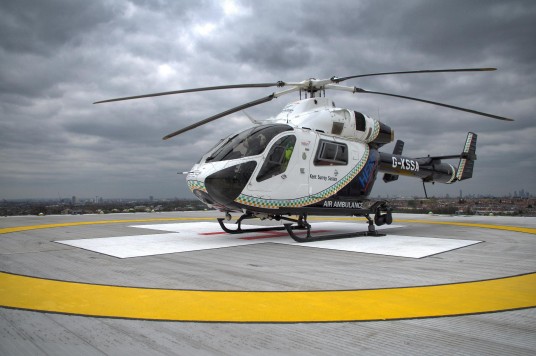Stroke patient flown to St George’s for urgent treatment
St George’s received its first hospital transfer stroke patient by air last week.
Kent Surrey & Sussex Air Ambulance were called to transfer a stroke patient from the William Harvey Hospital, Ashford to St Georges Hospital last week. The patient had failed to respond to his initial treatment and needed to have an urgent interventional radiology procedure known as a thrombectomy (removal of a blood clot from a vessel).
This is the first time St George’s has used its helipad to transfer a stroke patient for an interventional procedure. It was an unusual request for the Kent Surrey & Sussex Air Ambulance with inter-hospital transfers accounting for less than 1% of the charity helicopter team’s work. However in this case, saving time was critical and the Air Ambulance transfer took just 30 minutes to cover the 60 miles from Ashford to the rooftop helipad at St Georges, a journey that would have taken well over an hour by road.
It is thought that their successful 30 minute transit time between the two hospitals will have greatly contributed to the patient’s successful outcome. He was soon walking independently and was discharged from St George’s this week.
Dr Jeremy Madigan, Consultant Diagnostic & Interventional Neuroradiologist at St George’s Hospital said:
“A thrombectomy is a time critical procedure. The longer the brain’s blood vessels are blocked, the more likely it is that the brain tissue will die and this will worsen the disability for the patient if they survive.
“The transfer time of 30 min by helicopter can be compared to 1h24m normal road travel time. The option of helicopter transfer is significant in that it creates a much wider catchment area and opens up the availability of timely treatment at a specialist centre to a larger population.
“St George’s is one of the most experienced centres in the UK for delivering this treatment.”
Dr David Hargroves, Consultant Physician and Clinical Lead for Stroke Medicine, East Kent Hospitals University NHS Foundation Trust who treated the patient initially said:
“We have known for the last 20 years that clot busting drugs (fibrinolytic agents) can make a significant impact upon a patient’s chance of recovery, if given early enough. Recent evidence, suggests that in a small number of patients, following early intravenous fibrinolytic therapy, additional benefit may be gained from removal of the clot directly; but only if performed quickly. This is the most exciting advance in acute stroke care since the inception of stroke units.
“This new treatment is currently only performed in a few centres in the country – St Georges Hospital in London being one. A patient may lose 2 million neurones a minute when suffering an ischaemic stroke, accessing initial and rapid intravenous fibrinolytic therapy is therefore paramount and, if suitable, the clot removed quickly, The use of the Air Ambulance for transfer to an interventional centre makes this possible from East Kent.
“The patient is doing well and the speedy transfer went some way to ensuring a better outcome. The Kent Surrey & Sussex Air Ambulance takes referrals from a wide geographic area.”
Air Ambulance Operational Clinical Manager Richard de Coverly said:
“Kent, Surrey & Sussex Air Ambulance is hoping to continue supporting this exciting new service for stroke patients and in future assist taking referrals from a wide geographic area.”



